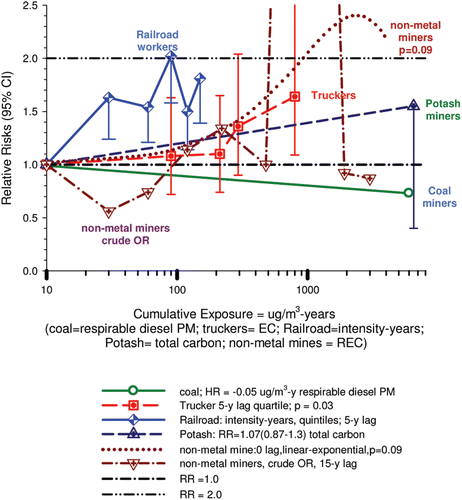Figures & data
Figure 1. Exposure-response of lung cancer and cumulative DME exposure among all cases and controls, women, non-smokers, those without working in jobs with known lung cancer risk; ORs adjusted for age, sex, study, ever employment in list “A” jobs, pack-years, time since quitting smoking (CitationOlsson et al., 2011).
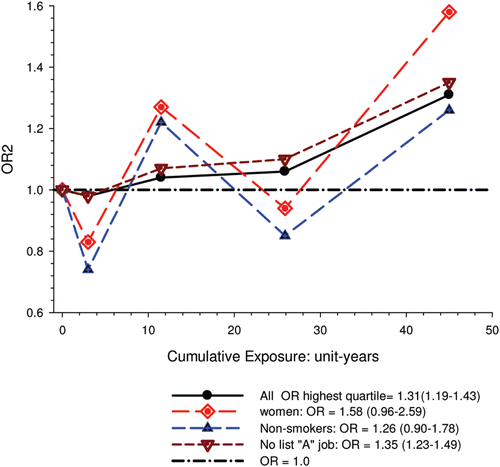
Figure 2. Lung cancer risk by years worked among workers only exposed to low levels and high levels of diesel motor exhaust exposure (CitationOlsson et al., 2011).
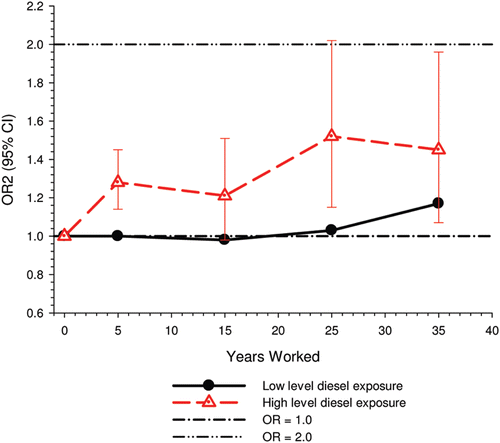
Table 1. Proportion of workers exposed to diesel emissions in selected occupations and usual exposure coding, Montreal, Canada, 1979–1985 (CitationParent et al., 2007).
Table 2. Comparison of ORs based on different DME exposure assessment and different relative scores for low and high exposure jobs (0 to 4) in the CitationPeter et al. (2011) study of INCO countries.
Figure 3. Adjusted odds ratios of lung cancer in relation to occupational exposure to diesel engine emissions with 5-year latency and men ≥40 years; partial adjustment for confounders is age and province; full adjustments for confounders is age, province, pack-years, second-hand smoke, silica and asbestos (CitationVilleneuve et al., 2011).
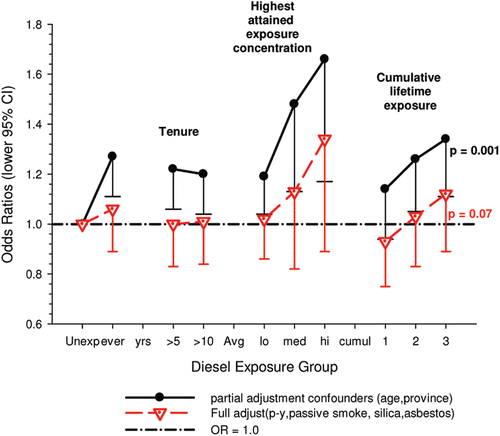
Table 3. Percentage of job periods exposed and risk estimates for lung cancer between three methods of exposure assessment in the INCO studies in Czech Republic, Hungary, Poland, Romania, Russia, Slovakia, UK from CitationPeters et al. (2011).
Table 4. Associations of educational attainment with exposure to DME (CitationMohner et al., 1998).
Figure 4. Adjusted odds ratios of lung cancer in relation to occupational exposures to diesel emissions, men 40+ years Canadian hospital-based case-control study (OR adjusted for age, province, pack-years, second-hand smoke, silica (Y/N), asbestos(Y/N)(p values refer to cumulative exposure) (CitationVilleneuve et al., 2011).

Figure 5. Adjusted odds ratios of lung cancer in relation to occupational exposures to gasoline emissions, men 40+ from Canadian hospital-based case-control study; ORs adjusted for age, province, pack-years, second-hand smoke, silica (Y/N) and asbestos (Y/N) (p values refer to cumulative exposure) (CitationVilleneuve et al., 2011).
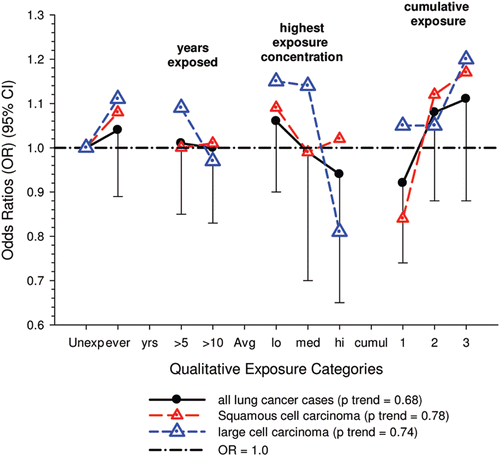
Figure 6. Odds ratios for the association of lung cancer and exposure to diesel emissions in population-based case-control studies in Europe and Canada (CitationOlsson et al., 2011) including subsets from Italy (CitationRichiardi et al., 2006), Stockholm (CitationGustavvson et al., 2000) and Germany (Bruske-Hohlfeld et al., 2000), Canada (CitationVilleneuve et al., 2011); Sweden (CitationBoffetta et al., 2001); Finland (CitationGuo et al., 2004), and Montreal, Canada (CitationParent et al., 2007).
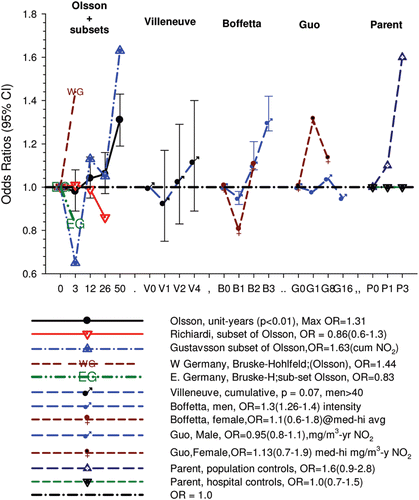
Figure 7. Odds ratios for the association of qualitative estimates of diesel exhaust exposure with all lung cancers and by histologic types from population-based case-control studies in Montreal, Canada (CitationParent et al., 2007), Sweden (CitationBoffetta et al., 2001), Finland (CitationGuo et al., 2004) and Canada (CitationVilleneuve et al., 2011).
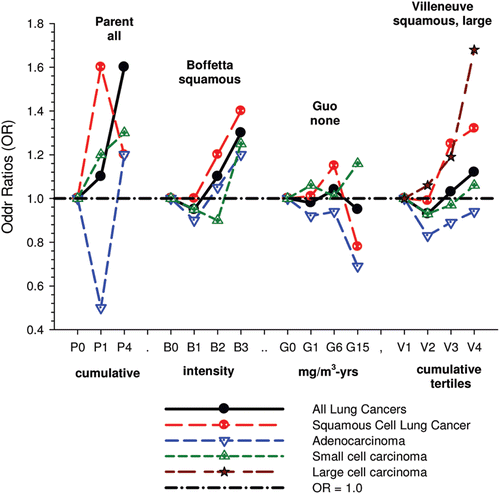
Table 5. Summary of exposure-response slopes and HRs for surface and underground (UG) workers using untransformed log-linear and log transformed regression models over full exposure range and restricted exposure range (<1280 µg/m3 years) for UG cohort for workers with 15-year lags and excluding workers with <5-year tenure (CitationAttfield et al., 2012).
Figure 8. Proportional Hazards ratios on lung cancer mortality for 15-year lagged REC cumulative exposure of surface worker, UG workers and the complete cohort adjusted and unadjusted for worker location in DEMS cohort study (, , in CitationAttfield et al., 2012).
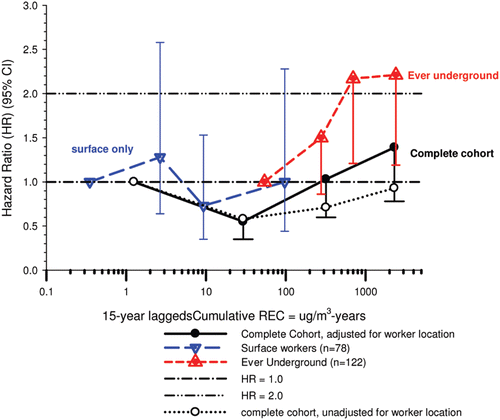
Figure 9. Proportional hazard ratios (HR) on lung cancer mortality for 15-year lagged REC cumulative exposure of surface workers, UG workers and complete cohort expanded categories excluding workers with ≤5-years tenure, , , in CitationAttfield et al. (2012).
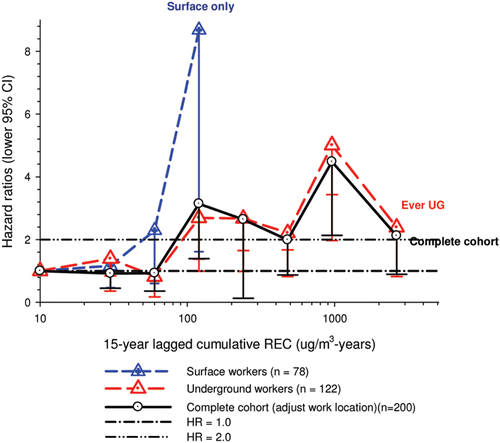
Figure 10. Proportional hazard ratios for lung cancer and cumulative REC among surface workers with 15-year lags and exclude workers with <5-year tenure in expanded categories, untransformed and log transformed regression models, and S8 from CitationAttfield et al. (2012).
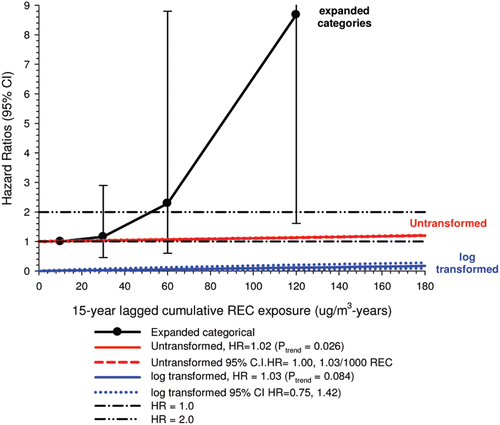
Figure 11. Proportional hazard ratios (HR) on lung cancer mortality for 15-year lagged REC cumulative exposure in UG workers excluding workers <5-years tenure; Expanded categorical model plus log-linear regressions for full and restricted exposure range <1280 μg/m3-years; log transformed model with full exposure range () (CitationAttfield et al., 2012).
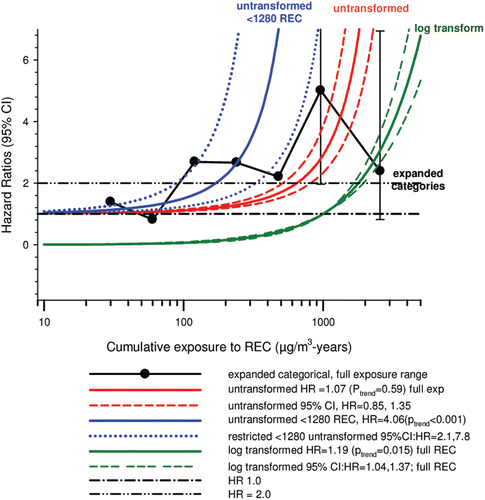
Figure 12. Proportional hazards ratios (HR) for lung cancer by 15-year lagged and unlagged REC cumulative exposure (µg/m3-years) for the complete cohort adjusted for worker location using expanded categorical cutpoints (Tables S5 and S6) (CitationAttfield et al., 2012).
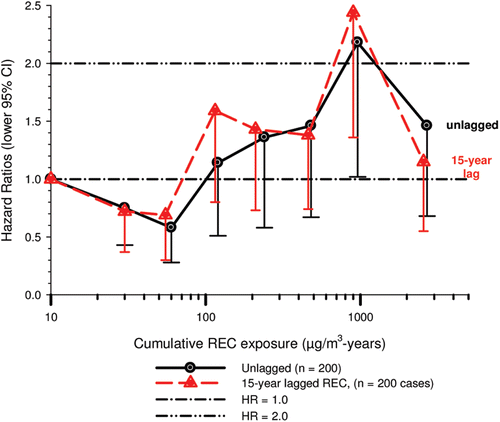
Figure 13. Proportional hazards ratios for lung cancer mortality by unlagged REC cumulative exposure (µg/m3-years) among Underground workers with expanded categories, untransformed (HR = 1.01) and log transformed regression (HR = 1.15) models for UG workers from Tables S6 and S8, CitationAttfield et al. (2012).
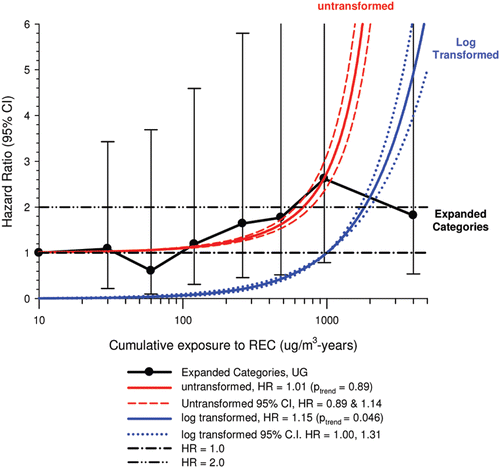
Figure 14. Proportional hazards ratios (HR) for lung cancer among underground workers by 15-year lags REC cumulative exposure (µg/m3-years) in expanded category untransformed (HR = 1.03/1000 μg/m3-year) and log transformed (HR = 1.07) regression models from their Tables S5 and S7 in CitationAttfield et al. (2012).
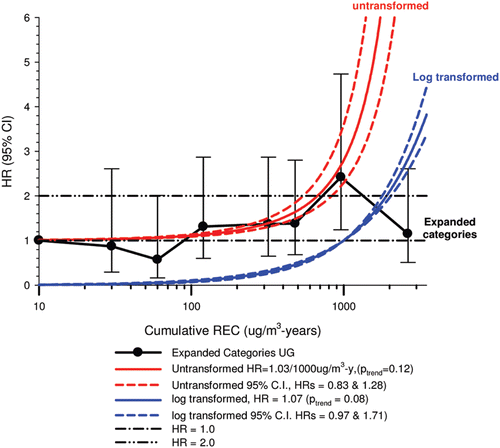
Table 6. Summary of exposure-response slopes and HRs for underground (UG) workers using untransformed and log transformed regression models over full cumulative exposure range for unlagged and 15-year lags (Table S7) (CitationAttfield et al., 2012).
Figure 15. HR for lung cancer and 15-year lagged cumulative REC for UG workers in expanded categories as referent: Attfield primary results = untransformed HR=4.06/1000 REC (exclude <5-year tenure, restrict <1280 REC) versus a priori results of untransformed HR=1.03/1000 REC and log transformed HR = 1.07 (no exposure restriction or tenure exclusions) and S7 in CitationAttfield et al. (2012).
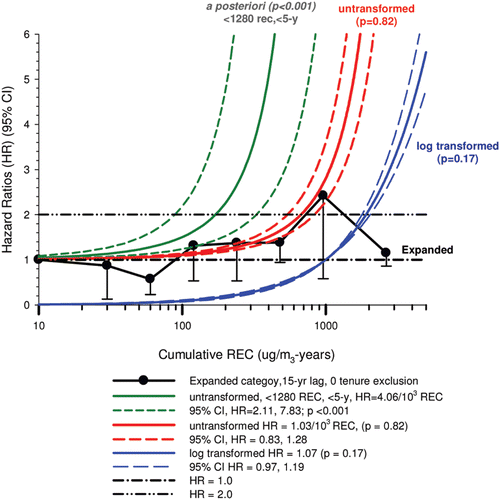
Table 7. Summary of increases in E-R slopes that always occur when deleting the high exposure category (>1280 µg/m3 years) (From Table S7 in CitationAttfield et al., 2012).
Figure 16. Lung cancer odds ratios for smoking status/smoking intensity for surface workers (REC = 0-8 µg/m3) versus UG workers (REC = 1–423 µg/m3) in case-control study (CitationSilverman et al., 2012, ).
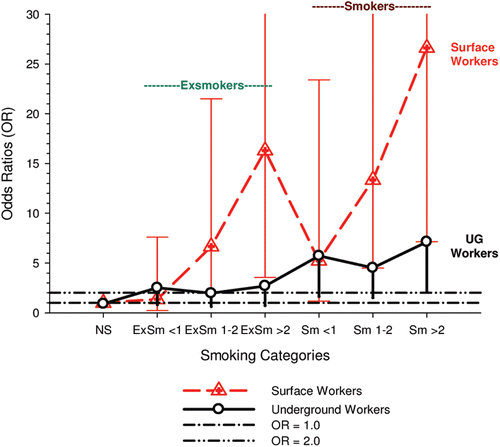
Figure 17. HRs and ORs of lung cancer and 15-year lagged cumulative REC among UG workers from cohort ( in CitationAttfield et al., 2012), adjusted ORs with smoking removed from model (ORs at cohort exposure cutpoints) (page 9 from CitationSilverman et al., 2012).
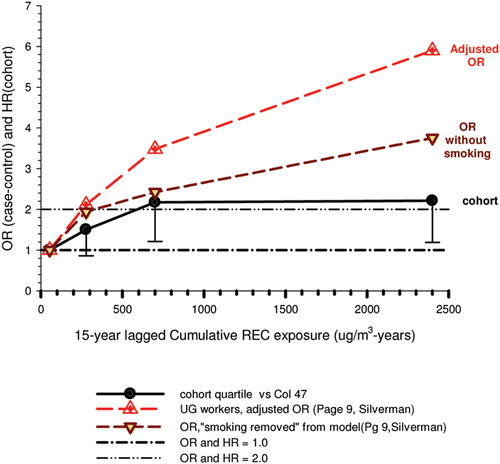
Figure 18. Relative risks of lung cancer with cumulative REC exposure among surface workers with and without 15-year lags in cohort study (15-year lags, in CitationAttfield et al., 2012) and case-control study (unlagged and 15-year lags) in CitationSilverman et al. (2012).
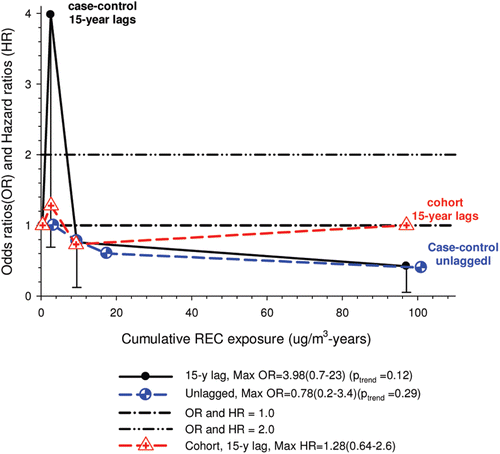
Figure 19. Lung cancer odds ratios for 15-year lagged cumulative REC for quartile, expanded categorical with split highest exposure category and continuous linear-exponential regression models for entire study population in case-control study (, S1 in CitationSilverman et al., 2012).
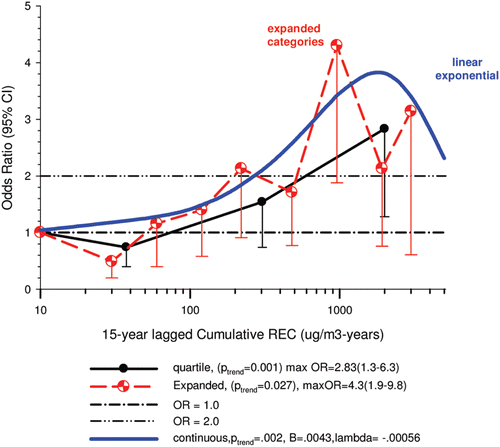
Figure 20. Odds ratios (ORs) and 95% confidence intervals for unlagged cumulative REC exposure and lung cancer in quartile and linear-exponential (β = 0.0016, λ = −0.00042) regression models in DEMS nested case-control and S3 in CitationSilverman et al. (2012).
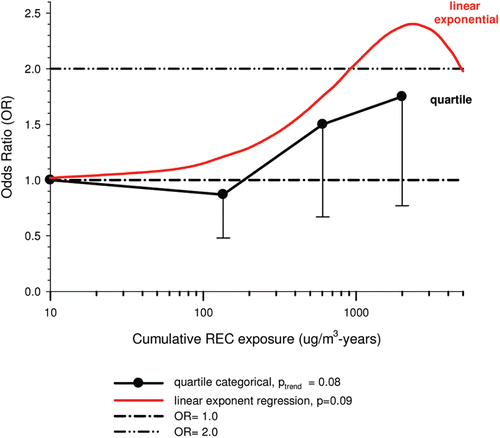
Figure 21. Odds ratios for lung cancer and cumulative REC in expanded category and linear-exponential (β = 0.0043, λ= −0.00056) models lagged 15-years and unlagged linear-exponential (β = 0.0016, λ = −0.00042) regression models from Tables S1, S2 and S3 in CitationSilverman et al. (2012)
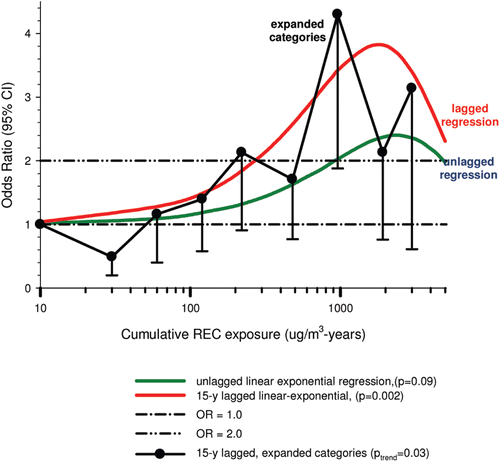
Figure 22. Lung cancer and cumulative REC with linear-exponential models unlagged with (a) full REC (β = 0.0016, λ = −0.00042) and (b) REC <1280 μg/m3-year (β = 0.0025, λ = −0.00011) versus 15-year lagged models with (c) full REC (β = 0.0043, λ = −0.00056) and (d) REC <1280 μg/m3-year (β = 0.0025, λ = +0.00053) from Tables S1 and S3 in CitationSilverman et al. (2012).
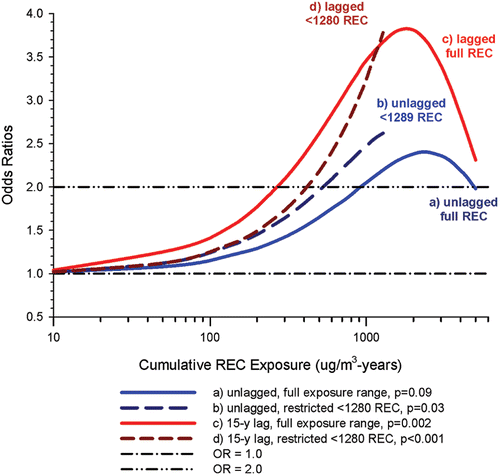
Figure 23. Distribution of 200 lung cancer cases in complete cohort by 15-year lagged and unlagged average REC intensity (µg/m3) with no tenure restrictions (Tables S5 and S6 from CitationAttfield et al., 2012).
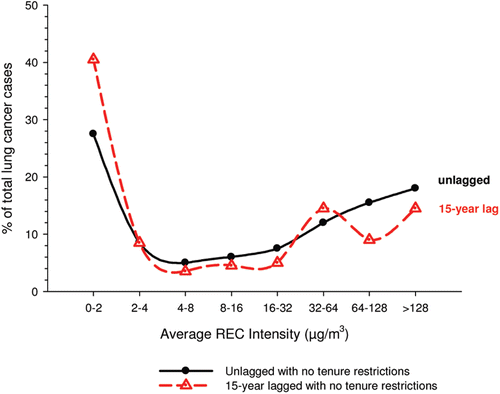
Table 8. Association of smoking prevalence by cumulative REC exposure among controls. Similar results obtained for cases and total cases + controls (calculated from Table 6 (CitationSilverman et al., 2012).
Figure 24. Adjusted and crude lung cancer ORs stratified by confounders from employment in other high risk occupations and history of respiratory disease ( in CitationSilverman et al., 2012).
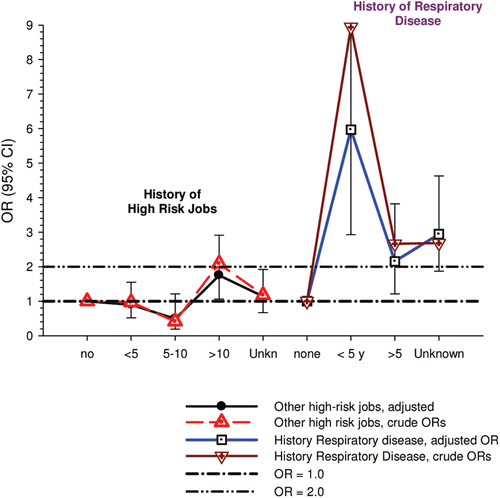
Figure 25. Crude and adjusted ORs for lung cancer and unlagged cumulative REC; ORs adjusted for 24 smoking × mine location, history of respiratory disease >5-years and history of high risk job for lung cancer >10-years; Crude ORs calculated from in CitationSilverman et al., 2012.
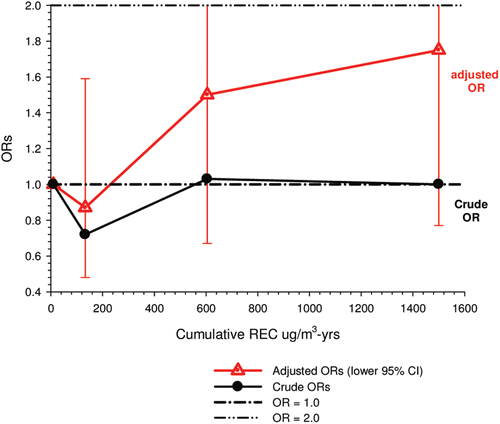
Figure 26. Crude and adjusted ORs for lung cancer and 15-year lagged cumulative REC; ORs adjusted for smoking × mine location interaction; >5-year history of respiratory disease and >10-year history of high risk jobs for lung cancer; crude ORs calculated from in CitationSilverman et al. (2012).

Figure 27. Crude and adjusted ORs for lung cancer and 15-years lagged cumulative REC for expanded exposure categories; ORs adjusted for smoking × mine work location, >5-year history of respiratory disease, and >10-year history of high risk jobs for lung cancer; crude ORs calculated from Table S2 in CitationSilverman et al. (2012).
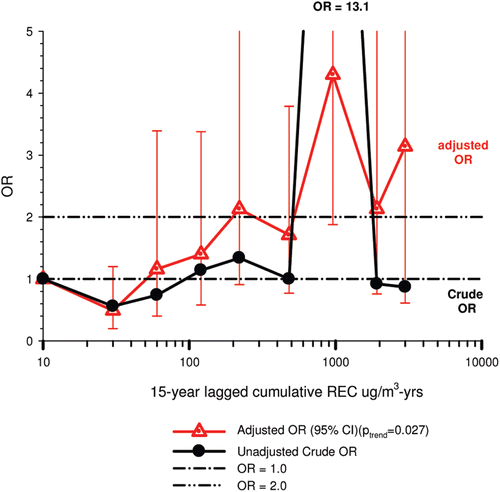
Figure 28. Crude and adjusted ORs for lung cancer and unlagged cumulative REC among underground (UG) workers; ORS adjusted for smoking × mine location, >5-years respiratory disease and >10 years history high risk job for lung cancer; crude ORs calculated from in CitationSilverman et al. (2012).
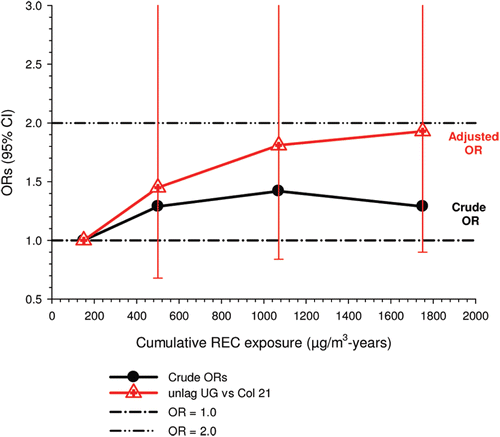
Figure 29. Crude and adjusted ORs for lung cancer and 15-year lagged cumulative REC among underground (UG) workers; ORs adjusted for smoking × mine work location, >5-year respiratory disease and >10-year history high risk job for lung cancer; crude ORs from in CitationSilverman et al. (2012).
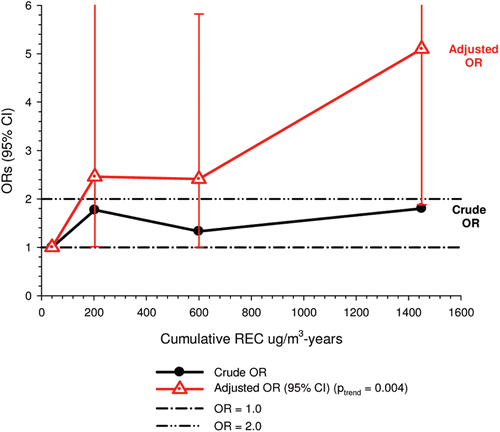
Figure 30. HR versus crude OR for Lung cancer and 15-year lagged REC cumulative exposure in expanded categories for complete cohort: HRs from Table S5 in CitationAttfield et al. (2012) and crude ORs calculated from Table S2 in CitationSilverman et al. (2012).
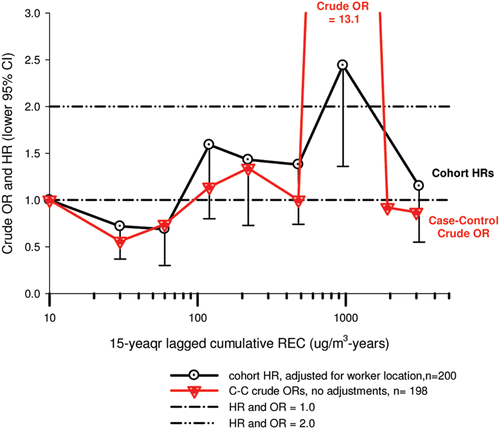
Table 9. Summary of diesel-exposed workers in occupational cohorts with quantitative or semi-quantitative estimates of cumulative exposure to diesel exhaust and analysis of exposure-response trends.
Figure 31. Exposure-response trends of Coal Miners (CitationJohnston et al., 1997), Truckers (CitationSteenland et al., 1998), Railroad engineers/conductors (CitationLaden et al., 2006); Potash miners (unadjusted for uranium confounding) (CitationNeumeyer-Gromen et al., 2009); US non-metal miners (crude and adjusted ORs) (CitationSilverman et al., 2012).
